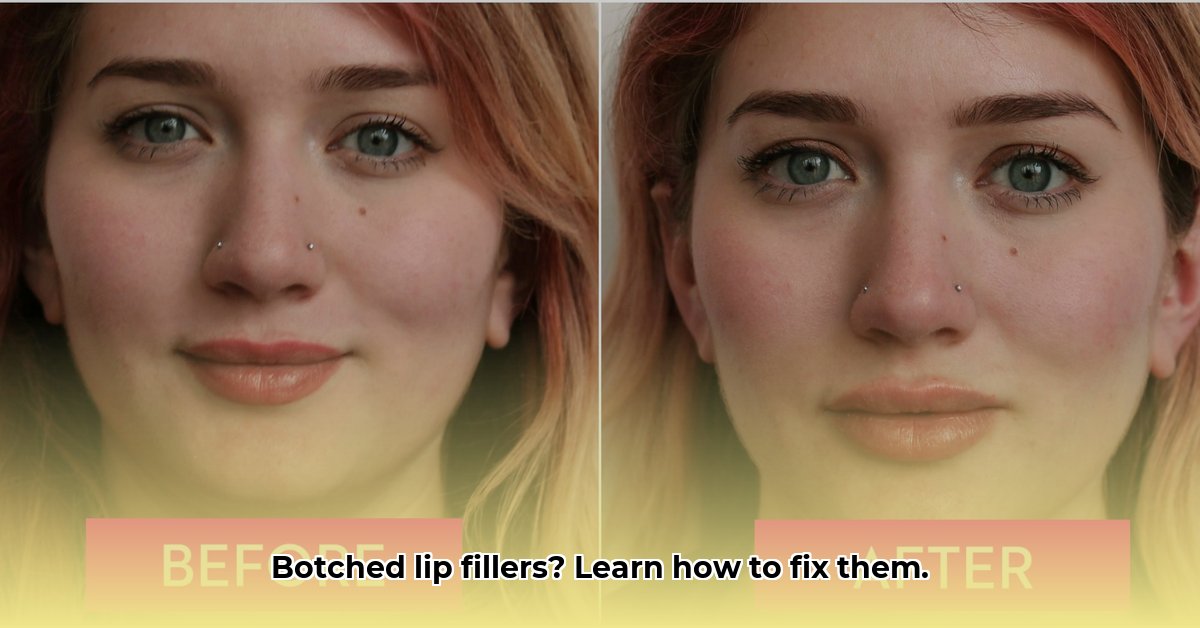Experiencing unexpected results after lip fillers can be incredibly distressing. This comprehensive guide provides clear, actionable information to help you understand the causes of bad lip injections, explore potential solutions, and learn how to prevent complications in the future.
Decoding Lip Filler Complications
“Bad” lip injections can manifest in various ways, ranging from subtle imperfections to more noticeable issues. Some common complications include:
- Lumps and Asymmetry: Uneven filler distribution can create a lumpy or asymmetrical appearance. This can sometimes resemble small pebbles under the skin or cause one lip to appear noticeably larger than the other.
- Overfilling: Injecting too much filler can result in an unnatural, exaggerated pout often referred to as “duck lips.” This can stretch the skin and create a disproportionate appearance.
- Migration: Filler can sometimes migrate beyond the intended lip border, creating a blurred lip line or an unnatural “shelf” above the lip.
- Tyndall Effect: In some cases, filler placed too superficially can create a bluish discoloration known as the Tyndall effect.
- Vascular Occlusion: While rare, this serious complication occurs when filler blocks a blood vessel, potentially leading to tissue damage or, in extremely rare cases, vision problems. Immediate medical attention is required if you suspect vascular occlusion.
Why Do Lip Injections Go Wrong?
Several factors can contribute to unsatisfactory lip filler results:
- Injector Expertise: A qualified and experienced injector is crucial. Proper filler placement requires a deep understanding of facial anatomy and injection techniques. An inexperienced injector may lack the precision and artistry to achieve natural-looking results.
- Filler Type and Quality: Different fillers have different properties. Using the wrong type of filler or a product of poor quality can lead to complications or undesirable outcomes. Always ask your injector about the specific filler they plan to use.
- Individual Anatomy and Response: Each individual’s anatomy and response to fillers are unique. Factors such as lip shape, skin elasticity, and healing tendencies can influence the final result. While a skilled injector will tailor the procedure to your individual needs, variations in outcomes are possible.
- Injection Technique: Even with the right filler and a skilled injector, improper injection technique can lead to uneven distribution, lumps, or migration. Too much filler injected in one area can also create an overfilled appearance.
- Unforeseen Complications: In some cases, unforeseen complications can arise even with a skilled injector and proper technique. This reinforces the importance of choosing a qualified professional who can effectively manage any unexpected issues.
Rescuing Your Results: Fixing Lip Filler Complications
If you’re unhappy with your lip filler results, don’t panic. Here’s a step-by-step guide:
- Consult a Qualified Professional: Your first step should be to contact a board-certified dermatologist or plastic surgeon specializing in corrective procedures.
-
Discuss Your Options: Depending on the specific issue, several solutions may be available, including:
- Hyaluronidase: This enzyme can dissolve hyaluronic acid-based fillers, reversing the effects of the injection. It’s a relatively quick and non-surgical option for correcting overfilling, asymmetry, or lumps.
- Surgical Removal: In some cases, surgical removal of filler may be necessary.
- Waiting and Massage: Minor issues like mild asymmetry or swelling may resolve on their own over time, potentially aided by gentle massage.
-
Follow Aftercare Instructions: Your practitioner will provide detailed aftercare instructions, which may include applying ice, avoiding certain activities, and keeping the area clean.
| Correction Method | Description | Approximate Cost | Typical Recovery Time |
|---|---|---|---|
| Hyaluronidase Injection | Dissolves hyaluronic acid fillers | $$ (Moderate) | A few days |
| Surgical Excision | Surgically removes filler | $$$ (Higher) | Several weeks |
| Natural Dissolution | Filler breaks down naturally over time (typically 6-12 months) | N/A | Months |
Preventing Lip Filler Problems: A Proactive Approach
The best way to manage complications is to avoid them in the first place. Here’s how:
- Thorough Research: Choose a board-certified dermatologist or plastic surgeon with extensive experience in lip injections. Look at before-and-after photos, read reviews, and ask for recommendations.
- Consultations Are Key: Schedule consultations with multiple providers to discuss your goals, ask questions, and assess their expertise.
- Start Conservatively: Begin with a small amount of filler and gradually add more if desired. This allows you to assess the results and avoid overfilling.
- Follow Pre- and Post-Care Instructions: Adhering to your injector’s instructions is crucial for minimizing risks and promoting optimal healing. This may include avoiding certain medications or supplements before the procedure and following specific aftercare guidelines.
- Understand the Risks: Be aware of the potential risks and complications associated with lip fillers, even with a skilled injector. Openly discuss these risks with your provider to make an informed decision.
Natural Lip Enhancement Alternatives
If you’re hesitant about fillers, consider non-invasive alternatives:
- Makeup Techniques: Overlining with lip liner or using lip-plumping glosses can create the illusion of fuller lips.
- Micro-needling: This procedure stimulates collagen production, potentially leading to subtle lip plumping over time.
Finding a Qualified Injector: Essential Criteria
- Board Certification: Verify board certification by the American Board of Dermatology or the American Board of Plastic Surgery.
- Specialized Experience: Look for an injector specializing in facial aesthetics and lip augmentation.
- Portfolio Review: Examine before-and-after photos to assess the injector’s aesthetic style and results.
- Comprehensive Consultation: Ensure the injector listens to your goals, thoroughly explains the procedure, and answers all your questions.
Ongoing Research and Evolving Knowledge
Research in aesthetics is constantly evolving. New techniques and filler materials are continually being developed. While current information suggests certain best practices, it’s essential to recognize that our understanding of fillers and their long-term effects is still developing. Choosing a qualified injector who stays up-to-date with the latest advancements is vital.
Disclaimer: This information is for educational purposes only and does not constitute medical advice. Consult with a qualified medical professional for personalized guidance and treatment.
- Your Perfect Bento Box Bag For Fresh And Tidy Meals - December 2, 2025
- Korean Meal Prep Made Easy For Delicious Weekday Meals - December 1, 2025
- Korean Food Meal Prep Makes Flavorful Weekday Meals Simple - November 30, 2025










